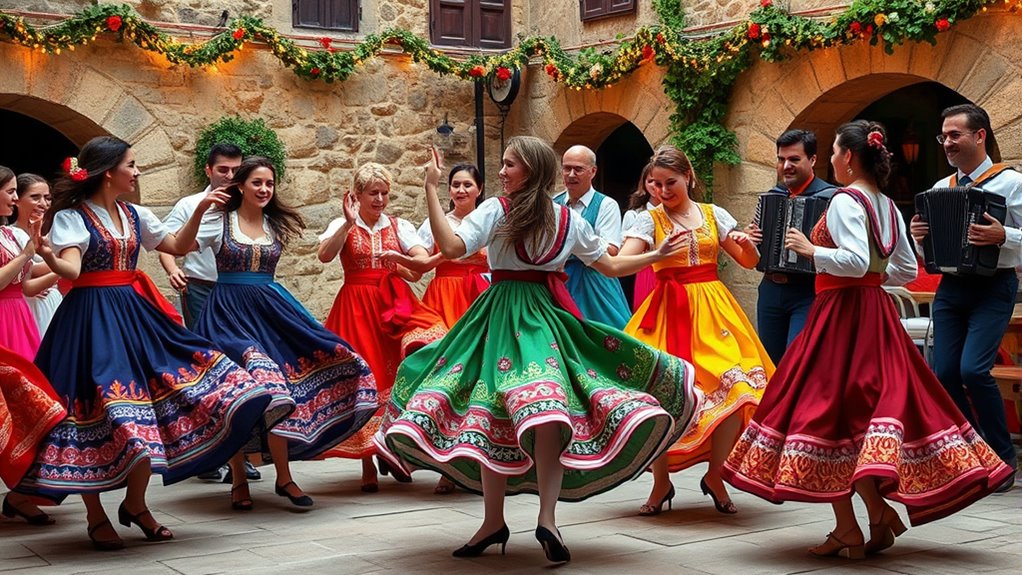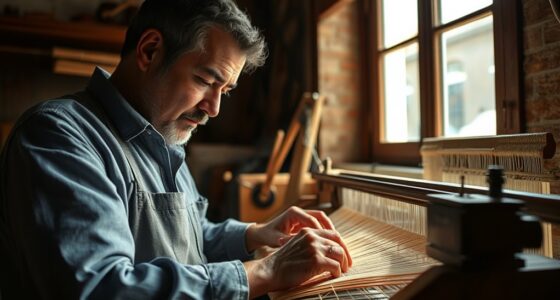Italian folk dances like the lively Tarantella and hypnotic Pizzica reflect the country’s rich cultural history and regional diversity. You’ll find energetic steps, rhythmic music, and unique traditions rooted in ancient rituals and local stories. Each dance varies across regions, blending superstition, celebration, and community pride. Exploring these dances reveals Italy’s vibrant heritage, and if you keep exploring, you’ll uncover even more fascinating stories behind each move and style.
Key Takeaways
- The Tarantella and Pizzica are iconic Italian folk dances with distinct regional origins and historical significance.
- Tarantella originated in southern Italy, linked to ancient rituals believed to cure tarantula venom through vigorous dancing.
- Pizzica comes from Puglia, rooted in pagan rituals, featuring rapid footwork and symbolizing community and regional pride.
- Both dances showcase regional variations in music, tempo, and instruments, reflecting Italy’s diverse cultural landscape.
- Preservation efforts maintain these traditional dances, emphasizing their cultural importance and evolving regional styles.

Have you ever wondered how traditional Italian dances capture the country’s rich history and vibrant culture? Italian folk dances like the Tarantella and Pizzica are perfect examples. These dances aren’t just lively movements; they’re woven into Italy’s cultural fabric, each with unique stories rooted in their historical origins and regional differences. When you explore these dances, you’re diving into centuries of tradition that have shaped local identities across Italy.
Italian folk dances like the Tarantella and Pizzica reveal Italy’s rich history and regional cultural diversity.
The Tarantella, for instance, traces back to southern Italy, particularly Sicily and Naples. Its origins are believed to be linked to ancient folklore and even mystical rituals meant to cure bites from the venomous tarantula spider. Historically, communities believed that dancing vigorously could rid the body of venom or curse, transforming fear into celebration. Over time, the Tarantella evolved from a ritualistic act into a lively social dance performed at festivals, weddings, and gatherings. Its energetic steps, spinning movements, and rhythmic tambourine music reflect a deep connection to Italy’s past, blending superstition with communal joy. You’ll notice that, despite its widespread popularity, the dance’s style varies from region to region. In Sicily, for example, it’s often accompanied by specific regional instruments like the tamburello, and the dance’s pace can be faster or slower depending on local traditions. This regional variation highlights how history and geography influence the way Italians celebrate their heritage through dance.
Similarly, the Pizzica, which originates from the Puglia region in southeastern Italy, has its roots in ancient pagan rituals and later became associated with healing practices. Historically, it was performed during festivals to ward off evil spirits or to mark seasonal changes. The dance involves rapid, hypnotic footwork and expressive arm movements, often performed in a circle, symbolizing community and unity. Over time, the Pizzica became more than a ritual—it’s now a symbol of regional pride and resilience. You’ll find that, although the core movements remain consistent, local variations of the Pizzica incorporate different musical instruments and tempos, reflecting the diverse cultural influences across Puglia. These regional differences are essential—they show how a dance can adapt over centuries, maintaining its essence while resonating uniquely with local communities. Moreover, the preservation of these regional variations is supported by cultural heritage preservation efforts that help keep traditional dances alive for future generations.
In essence, Italian folk dances like the Tarantella and Pizzica are more than just entertainment. They’re living expressions of history, shaped by regional differences that keep Italy’s cultural tapestry vibrant. By understanding their origins and variations, you gain a deeper appreciation for how dance can preserve stories, beliefs, and identities across generations.
Frequently Asked Questions
How Did Italian Folk Dances Originate Historically?
Italian folk dances originated from their rich cultural history, rooted in community celebrations and traditional rituals. You can see their historical origins in ancient times when dance was a way to express joy, tell stories, and preserve regional identities. These dances hold cultural significance today, linking past and present, and allowing you to connect with Italy’s vibrant heritage through lively movements and regional styles that reflect local history and traditions.
What Instruments Are Traditionally Used in These Dances?
Have you ever wondered what fuels the lively spirit of these dances? Traditional instruments like tambourines, accordions, violins, and drums drive the rhythm, blending regional music influences to create vibrant sounds. These instruments energize dancers and reflect local traditions. By using such instruments, these dances preserve cultural identity while inviting everyone to join in the celebration. Isn’t it amazing how music connects us to our roots?
How Do Regional Variations Influence Dance Styles?
Regional variations markedly influence dance styles by incorporating local costume variations and dialect influences. You’ll notice different movements, tempo, and expressions reflecting regional culture, history, and language. These differences shape how dancers perform, making each style unique to its area. You can see how regional costumes add authenticity, while dialect influences may even affect the music’s lyrics or rhythm, creating a rich, diverse tapestry of Italian folk dance traditions.
Are These Dances Still Performed at Festivals Today?
You’ll find these dances, like the Tarantella and Pizzica, still performed at festivals today, thanks to strong preservation efforts. Many communities celebrate their cultural heritage, boosting their modern festival popularity. These lively dances draw crowds and keep traditions alive, blending history with contemporary festivities. So, if you attend a festival in Italy, you’re likely to experience these vibrant dances, connecting past and present through lively, authentic performances.
What Are Common Costumes Worn During These Dances?
You’ll see dancers wearing vibrant costumes during these traditional dances. Men often wear embroidered shirts with traditional embroidery and bright sashes, while women don colorful skirts adorned with intricate embroidery and lively patterns. Both genders accessorize with colorful accessories like floral headpieces or shawls. The costumes reflect regional styles, emphasizing rich embroidery and vivid colors that celebrate local heritage and make the dances visually stunning.
Conclusion
As you explore Italian folk dances like the lively tarantella and passionate pizzica, you see how each regional variation tells its own story. These dances are more than moves; they’re a vibrant expression of Italy’s rich culture. Remember, “A picture is worth a thousand words,” and in these dances, every step paints a vivid picture of tradition, history, and community. Embrace the rhythm, and you’ll feel Italy’s heart beating in every dance.








